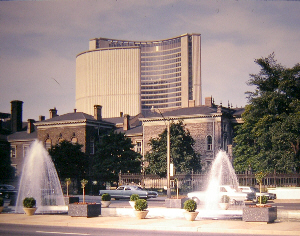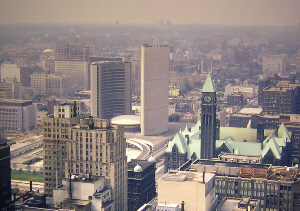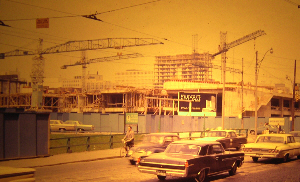Toronto’s City Hall with its curved twin towers rising in stately fashion above the domed Council Chamber, with the great plaza, “Nathan Phillips Square” in front; and with the two impressive nineteenth century structures, Osgoode Hall to the west and Old City Hall to the east, has become the primary symbol of this city.

New City Hall rises above Osgoode Hall June 1965
Opened ceremoniously at 2:00 p.m. on September 13. 1965, by Governor-general Georges Vanier, the new City Hall was welcomed by Torontonians and the City celebrated for a week. Unfortunately, the festivities were marred by the absence of the architect Viljo Revell, who passed away a few months before. He had won an international competition to build it.

Fireworks marked the opening of the New City Hall
Controversy dogged the project from its beginning. As early as the 1940s, The City knew that it needed a new administration building. There wasn’t enough space in the old City Hall, opened in 1899, to house the complex bureaucracy required to operate the large city that Toronto was becoming. In 1946, City Council approved funds to acquire the land for the new building and for an adjacent civic square. Because the chosen site required the destruction of two of the City’s best-known landmarks, Shea’s Hippodrome, a theatre on Bay Street, and the handsome Beaux Arts Provincial Registry Office at Albert and Chestnut Streets, let alone much of old Chinatown, appreciable opposition developed. The resulting discussion presaged the great political conflicts of the following decades between those supporting new development at all costs and those advocating preservation of the City’s architectural past.

Old and New City Halls from the Bank of Commerce Building, August 8, 1965
In 1955, because the voters rejected the City’s design proposal, Mayor Nathan Phillips, and the City Council decided that there would be an international architectural competition. This approach had worked well in the past; the Old City Hall was built after a similar procedure. The opportunity to design this structure attracted 520 entrants from 44 countries. Viljo Revell, a 48-year old Finn, won the $25,000, plus-commission prize, with his distinctive City Hall design. As he was not a registered architect in this country, a Canadian firm, John B. Parkin Associates, was selected to work with Revell in the erection of this building. That firm still provides advice on important architectural issues involving the building. Not everyone was pleased, however; the renowned American architect Frank Lloyd Wright panned it: ‘This marks the spot where Toronto fell.” But neither Toronto nor its new City Hall fell. The site was cleared and construction started November, 1961. The building was finished in 1965.

New City Hall under construction May 1963
There were problems along the way. Costs skyrocketed from an original estimate of $7 million to an eventual $30 million. Council balked at the choice and the cost of furniture, which was specially designed for this modern office.
In 1961, The City Council named the plaza in front of the Hall “Nathan Phillips Square.” honouring the Mayor’s unprecedented thirty-six years’ service in municipal politics and also recognizing his contribution to the new project. Phillips, who was often called the “Mayor of All the People” later personally donated the Nathan Phillips Square sundial.
Much of this information came from a news release issued by the City of Toronto to mark the 20th Anniversary of Toronto City Hall, September 9, 1985. More information can be found on the City of Toronto website.
For information about earlier city halls go to: Old City Hall and First City Hall.
